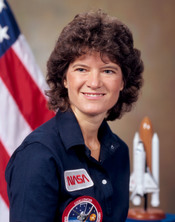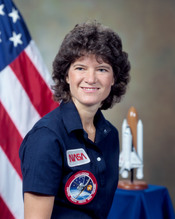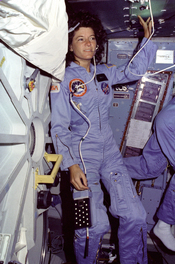Sally Kristen Ride
First American Woman in Space
Born: May 26, 1951
Our future lies with today's kids and
tomorrow's space exploration.
--Dr. Sally Ride
--------------------------------------------------------------------------------
Sally Kristen Ride was born on May 26, 1951 in Encino, California (near Los Angeles). Sally started playing tennis at age 10, and became an excellent tennis player. She won a tennis scholarship to Westlake School for Girls in Los Angeles. After graduation in 1968 she attended Swarthmore College, but dropped out to pursue a career in professional tennis. After three months of hard practice, Sally decided she was not good enough to become a successful pro. She quit tennis and enrolled at Stanford University.
At 27, with B.A., B.S., and masters' degrees, she was a Ph. D. candidate looking for postdoctoral work in astrophysics when she read about NASA's call for astronauts in the Stanford University paper. More than 8,000 men and women applied to the space program that year.
35 were accepted, six of whom were women. One was Sally Ride.
After joining NASA in 1977 Ride underwent extensive training that included parachute jumping, water survival, gravity and weightlessness training, radio communications and navigation. She enjoyed flight training so much that flying became a favorite hobby. During the second and third flights of the space shuttle Columbia (November 1981 and March 1982), Ride served as communications officer, relaying radio messages from mission control to the shuttle crews. Dr. Ride was also assigned to the team that designed the remote mechanical arm, used by shuttle crews to deploy and retrieve satellites.
In 1983, Dr. Sally Ride became the first American woman in space on the shuttle Challenger (STS-7). Her next flight was an eight-day mission in 1984, again on Challenger (STS 41-G). Her cumulative hours of space flight are more than 343.
Ride was preparing for her third mission when Challenger exploded in 1986. When training was suspended, she was appointed to the Presidential Commission charged with investigating the accident. She moved to NASA headquarters in Washington, D.C., where she became assistant to the NASA administrator for long-range planning. Ride created NASA's "Office of Exploration" and produced a report on the future of the space program, "Leadership and America's Future in Space."
Dr. Ride retired from NASA in 1987 to become a Science Fellow at the Center for International Security and Arms Control at Stanford University. After two years, she was named Director of the California Space Institute and Professor of Physics at the University of California, San Diego where she pursued one of her heartfelt crusades, encouraging young women to study science and math.
In June, 1999 Ride joined space.com, a website about the space industry, as Executive Vice President and member of its Board of Directors. In September, 1999 she was named President of the company, a position she held until September, 2000.
After leaving space.com, Dr. Ride initiated and headed EarthKAM, an Internet-based NASA project that allows middle-school classes to shoot and download photos of the Earth from space. Her most recent enterprise is Imaginary Lines, an organization founded to provide support for all the girls who are, or might become, interested in science, math and technology. One instrument of this mission is the Sally Ride Club, created for upper elementary and middle school girls across the country.
Dr. Ride has received numerous awards, including the Jefferson Award for Public Service, the Women's Research and Education Institute's American Woman Award, and twice awarded the National Spaceflight Medal. An advocate for improved science education, Ride has written four children's books, "To Space and Back", "Voyager: An Adventure to the Edge of the Solar System", "The Third Planet : Exploring the Earth from Space", and "The Mystery of Mars".


